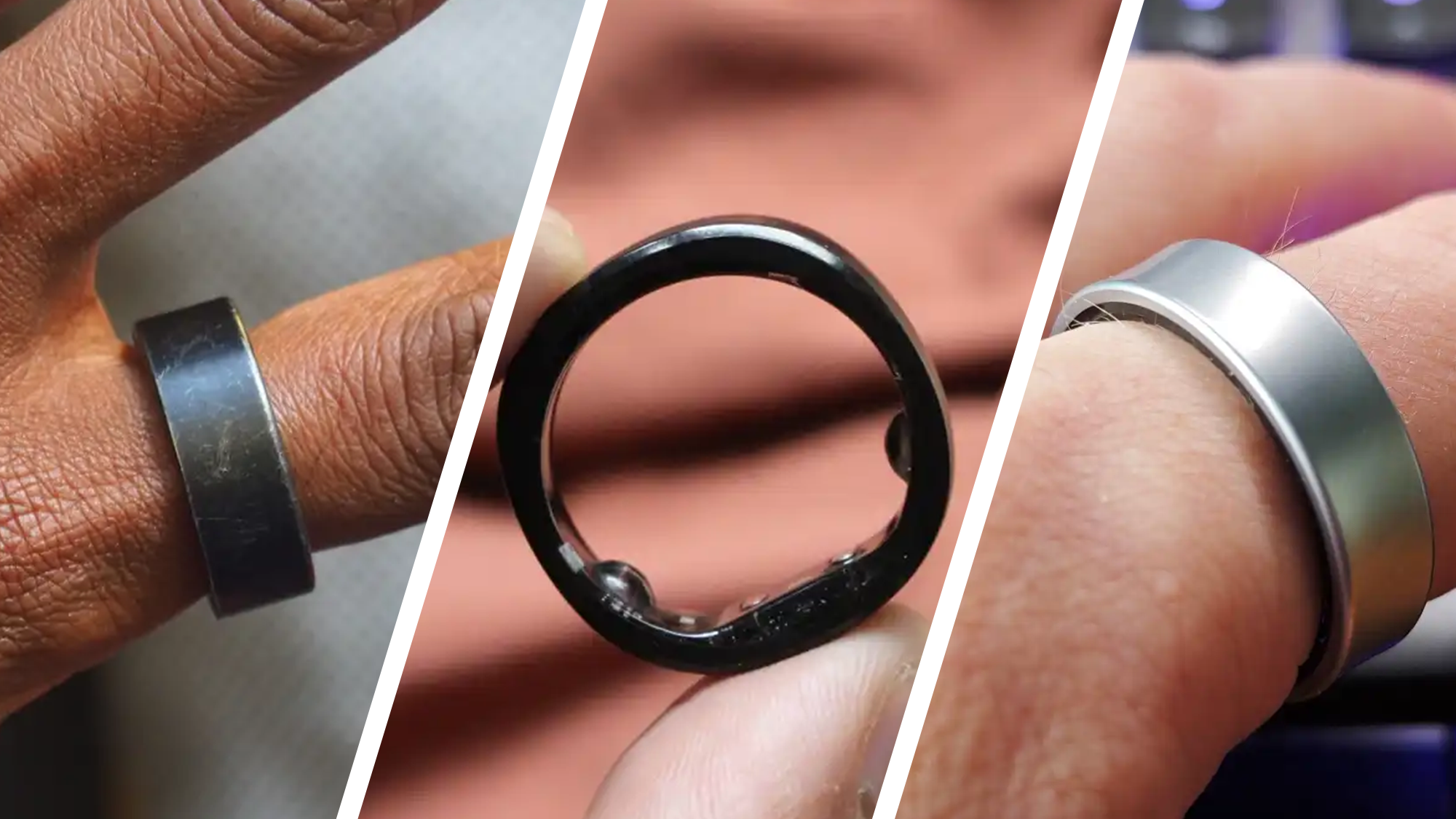Smart rings have been around for a while in one form or another but they’ve now come of age and hit the mainstream. With that in mind, here are the best models you can buy right now.
One of the smallest wearables you can get, they’re exactly what they sound like – rings you wear on the finger of your choice and track things like steps, heart rate, sleep and more.
It means you don’t have to wear a smartwatch (or budget smartwatch), freeing up your wrist for a proper timepiece if that’s your thing. They will often last longer than smartwatches and are more comfortable to wear at night. You’re just reliant on the companion app to interact with, instead of any screen on the device itself.
Why you should trust us: At Tech Advisor, we’ve been testing technology for almost 30 years, and we specialise in buying advice. We’ve been reviewing smart rings for a few years now but it’s taken a long time for the category to get off the ground. All our in-house team and freelance contributors are trained experts in rigorously testing devices.
What started with some niche brands has now got to the point where Samsung has joined the party. And that’s one of the top options here despite being a first-generation product.
Note that the Oura Ring 4 is official and we’re still waiting for a review sample. It will be added to this list as soon as possible but the Amazfit Helio Ring is a new entry and a very affordable option.
For now, here are the best smart rings we’ve tested. See below the chart for smart ring buying advice.
Best smart ring 2025
1. Samsung Galaxy Ring – Best Overall

Pros
- Stylish and comfortable
- Good user experience
- Solid core tracking
- Excellent charging case
Cons
- Erratic stress tracking
- Expensive
- Doesn’t feel like metal
Despite lots of models to choose from across the market, we don’t think any tech brands have perfected the smart ring yet – far from it, However, the Galaxy Ring is the best choice for most people right now.
Although it’s a first-generation product, Samsung has done a great job of offering a solid all-round experience. The ring itself looks nice and is more durable than rivals, so it stays looking good, even though it doesn’t feel like titanium.
The fitness and wellbeing tracking is mostly solid, with erratic stress tracking the main downside. Battery life is also very good and the charging case is brilliant.
It’s one of the most expensive rings on the market which could put it out of reach for many but there are no subscription fees here.
2. RingConn Gen 2 – Best Battery Life

Pros
- Slim, light and comfortable
- Class-leading battery life
- Solid core tracking
- Affordable and no subscription
Cons
- Susceptible to scratches
- Sleep apnea monitoring drains battery
- Some features still in beta
If you hate having to charge your gadgets then the RingConn Gen 2 is the right smart ring for you.
It outlasts rivals by some margin, with up to 12 days battery life. Furthermore, the convenient charging case can top the ring up an impressive 15-20 times.
We found the RingConn Gen 2 comfortable to wear 24/7, although the design is prone to scratches, which is a big shame.
Elsewhere, the core tracking is strong and the smart ring is one of the cheaper options (currently via Kickstarter) and doesn’t come with any subscription fees either.
It doesn’t have the best software experience, with a few gripes and features in beta, but that should get better over time.
3. Oura Ring Gen 3 – Best Design

Pros
- Simple, attractive design
- Excellent software experince
- Recovery-focussed tracking
Cons
- Expensive
- Almost useless without a paid subscription
- Limited workout tracking
Arguably the biggest name in the smart ring market, Oura is already onto its third-generation of smart ring and it’s one of the best options on the market for various reasons.
It’s the smart ring with the widest choice of shapes and colours, meaning there’s something for everyone. It also has one of the best software experiences out there, focusing on recovery rather than blindly pushing you to nominal targets.
However, it’s not perfect, starting with the fact it scratches easily. The fairly high price is also accompanied by a subscription service that you need to get the most out of it.
It could well be worth getting the Oura Ring 4 at this point, which has just been announced but the Gen 3 has seen significant price drops making it better value. Also find out how the Oura Ring 4 compares to the Gen 3.
4. Amazfit Helio Ring – Best Value

Pros
- Distinctive design
- Good core tracking
- Revamped companion app
- Affordable
Cons
- Only three sizes & one colour
- A tad chunky
- Battery life with all tracking enabled
The Amazfit Helio Ring is Zepp Health’s debut smart ring and like other challengers to the smart ring throne, it comes subscription-free, which helps to make it one of the cheapest smart rings you can buy.
You’re more restricted with the ring sizes compared to other smart rings with only one colour choice on offer. It’s not the slimmest ring available but is still a good-looker that can survive in water up to 100 metres deep.
It’s capable of tracking steps, sleep, stress and heart rate and does a good job of it across the board. Using it alongside a compatible Amazfit smartwatch can fill in the data gaps for areas like exercise where it can struggle, to ensure you can make the most of its headline Readiness metric, which is displayed in Zepp Health’s revamped companion app.
The promised 4-day battery life seems a touch optimistic based on our testing, but if you want a smart ring that’s more affordable than the competition and one of the few ring sizes available is a good fit, it’s a good albeit not groundbreaking entry into the world of smart rings.
5. Ultrahuman Ring Air – Best Comfort

Pros
- Very light and comfortable
- Solid core fitness and sleep tracking
- No subscription required
- Useful notification prompts
Cons
- Prone to scratches
- Not built for workout tracking
One of the most balanced rings on the market, the Ring Air from Ultrahuman is affordable (although not the cheapest) and without subscription fees, and there’s a lot to like about it.
The design is attractive and comfortable, although like many, prone to scratches.
It offers strong core tracking and a nice companion app where the data and insight are presented in a pleasing, helpful and intuitive way. The app does have to lean on some third-party integration to fill some gaps, though.
Battery life lags behind some rivals and we wish it had a charging case rather than a cradle, preventing it from being any higher in this list.
6. Circular Ring Slim (2024) – Thin & Affordable

Pros
- Light and comfortable
- Continuous heart rate monitoring
- Two battery modes
- Vibration motor option
Cons
- Unreliable tracking
- Busy companion app
- Slow data syncing
- Awkward charger
If having a thin smart ring is top of your wish list, then the Circular Ring Slim ticks that box, although it’s not a huge difference to some rivals – the RingConn Gen 2 is now thinner at 2mm vs 2.2mm.
Still, this thin and light design is one of the main reasons to opt for the Ring Slim over many rivals, along with its affordable price and optional vibration motor model to give you alerts and wake you up in the morning.
It also offers two battery modes and continuous heart rate monitoring, But there are various downsides too, including some software and syncing issues. Also, the tiny charging dongle is awkward and some of the tracking is unreliable.
FAQ
What is the point of a smart ring?
As mentioned in the intro, the idea of a smart ring is to do a lot of what a smartwatch or fitness tracker does but on your finger.
A set of sensors inside means they can typically track your steps, heart rate, sleep and potentially other things like stress and blood oxygen levels.
It provides a small, light and discreet way of gathering data on your daily activities and frees up your wrist to wear a regular watch.
Or, you could wear it in conjunction with a smartwatch. In Samsung’s case, this will provide more accurate tracking and increase the battery life of the Galaxy Ring by up to 30%.
Is a smart ring worth it?
Of course, this depends on how you answer various questions. Primarily, do you want to wear a fitness tracker on your finger that, at least at the moment, costs more than most smartwatches?
Is there one you like the look of, since this is more of a fashion choice than other wearables? And are you ok with it not having a display to provide you with information? You’ll need to use the companion app for everything.
They also last longer than a lot of smartwatches, so often only need recharging once a week.
There are also limitations of what a smart ring can do due to its size, so smartwatches can often track more data and have the ability to automatically track activities and workouts.
What are the disadvantages of smart rings?
As with anything, there are downsides to smart rings, starting with the fact they are generally more expensive than a lot of smartwatches and some even come with subscription fees.
They’re more of a faff to buy as you need to make sure you select the right size – although many offer a free sizing kit. Getting the right fit is crucial for accurate tracking and to make sure you don’t get it stuck or conversely it falls off too easily.
The lack of a display means you can’t really do anything without looking at your phone – though some have a vibration motor option for some feedback.
Also, most don’t come with NFC to enable contactless payments, unlike smartwatches.
What finger do you wear a smart ring on?
To an extent, you can wear a smart ring on whatever finger you choose. However, most smart ring makers suggest you avoid your thumb.
You should also wear a smart ring on your non-dominant hand and manufactures typically agree that the index finger provides the most accurate tracking. It’s also the best for ones like the Galaxy Ring, which includes pinch gestures as a feature.
Wearing it on your index finger will also help to avoid it rubbing against a wedding ring if you wear one.




